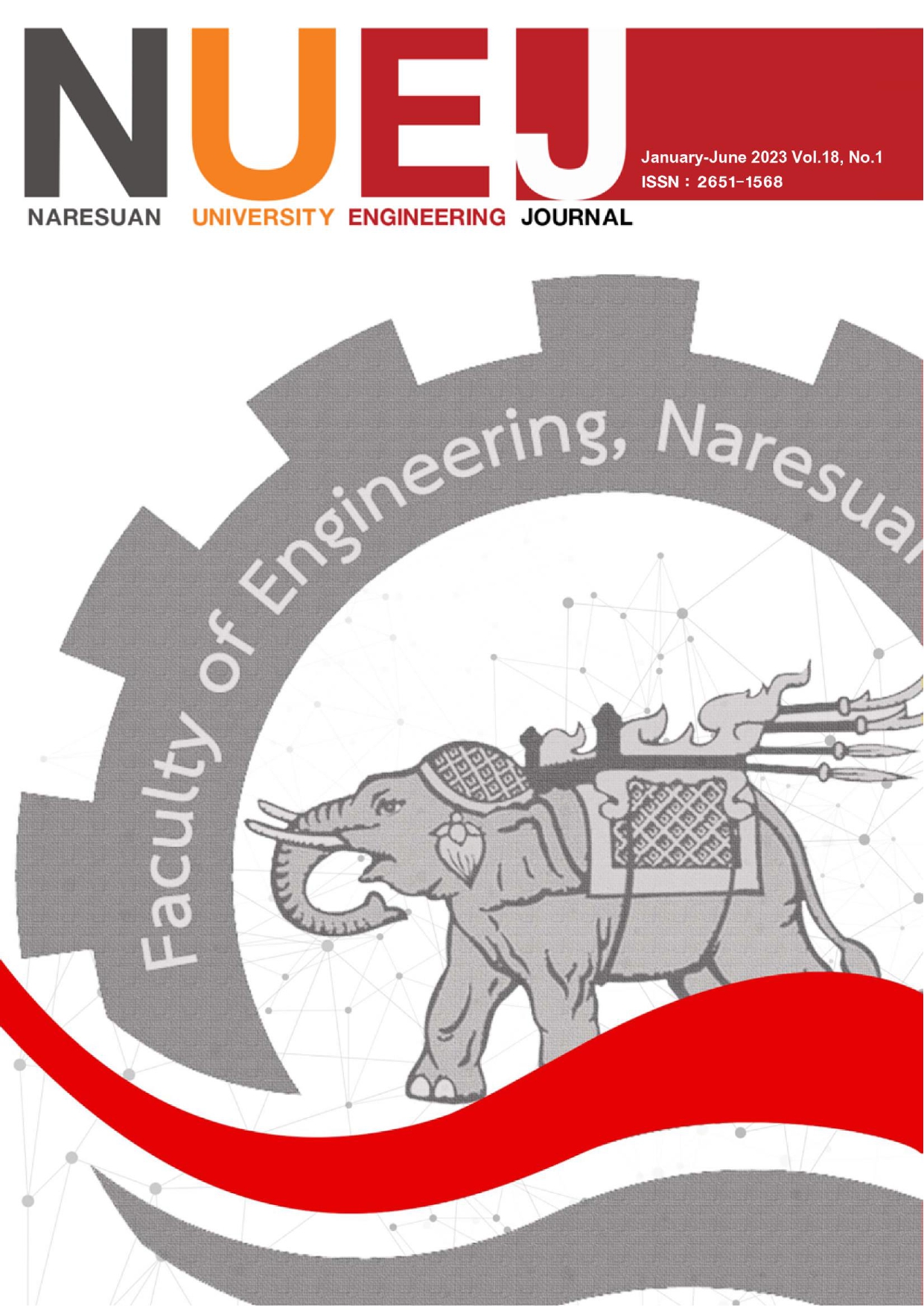The Microwave Pretreatment Effects on Yield and Tocopherol Content of Cold-Pressed Sesame Oil
Main Article Content
Abstract
The benefits of black sesame have long been recognized, and black sesame has been used for consumption, cosmetics for hair and skin care, and medication. One process used to produce high quality black sesame oil is the cold pressed process, where temperature is controlled to be lower than 60 oC throughout the process. However, this process results in a lower yield than extraction by solvent. Therefore, with the aim of enhancing efficiency, this study is examining the impact of a microwave pretreatment on the output of cold pressing black sesame oil. The experiment tested three conditions, with different microwave wattages and pretreatment durations, while temperatures were controlled slightly below 60 oC under all conditions. The effects of microwave pretreatment on seed color and weight loss profile of black sesame were studied. Tocopherol, one of the significant compounds of sesame oil, was also examined. It was found that under all conditions, microwave pretreatment increased yields from black sesame cold pressing by 8% relative to pressing with no pretreatment. In addition, higher g+β tocopherolin levels were found in the black sesame oil extracted after the pretreatment process, and the highest g+β tocopherol levels were found after using low microwave wattage with a longer duration of pretreatment. It was also found that the weight loss rate of black sesame seed increased as the microwave power was increased. Besides, as compared to the non-activated one, 180 W sesame seed showed the highest value of color difference.
Article Details

This work is licensed under a Creative Commons Attribution-NonCommercial-NoDerivatives 4.0 International License.
References
Bakhshabadi, H., Mirzaei, H., Ghodsvali, A., Jafari, S. M., Ziaiifar, A. M. & Farzaneh, V. (2017). The effect of microwave pretreatment on some physico-chemical properties and bioactivity of black curmin seed’s oil. Industrial Crops and Products, 97, 1–9. http://dx.doi.org/10.1016/j.indcrop.2016.12.005
Bose, P., Pradhan, D., Sonawane, A., Pathak, S. S., Anupriya, S. & Pradhan, R. C. (2020). Optimization of hot air and microwave pretreatment for enhancing the mechanical expression yield of Simarouba glauca oil. J. Agric. Res., 2, 100024. https://doi.org/10.1016/j.jafr.2020.100024
Dogruer, I., Uyar, H. H., Uncu, O. & Ozen, B. (2021). Prediction of chemical parameters and authentication of various cold pressed oils with fluorescence and mid-infrared spectroscopic methods. Food Chem., 345, 128815. https://doi.org/10.1016/j.foodchem.2020.128815
Eom, S. J., Zu, H. D., Lee, J., Kang, M. C., Park, J., Song, K. M. & Lee, N. H. (2021). Development of an ultrasonic system for industrial extraction of unheated sesame oil cake. Food Chem., 354, 129582. https://doi.org/10.1016/j.foodchem.2021.129582
Gharby, S., Harhar, H., Bouzoubaa, Z., Asdadi, A., Yadini, A.E. & Charrouf, Z. (2017). Chemical characterization and oxidative stability of seeds and oil of sesame grown in Morocco. Journal of Saudi Society of Agricultural Sciences, 16, 105–111. https://doi.org/10.1016/j.jssas.2015.03.004
Gornas, P., Sne, E., Siger, A. & Seglina, D. (2014). Sea buckthorn (hippophae rhamnoides L.) leaves as valuable source of lipophilic antioxidants: the effect of harvest time, sex, drying and extraction methods. Industrial Crops and Products, 60, 1–7. http://dx.doi.org/10.1016/j.indcrop.2014.05.053
Hosseini, S.D., Nayebzadeh, K., Mirmoghtadaie, L., Kavosi, M. & Hosseini, S.M.(2017). Effect of extraction process on composition, oxidative stability and rheological properties of purslane seed oil. Food Chem., 222, 61–66. http://dx.doi.org/10.1016/j.foodchem.2016.11.150
Kha, T. C., Nguyen, M. H., Roach, P. D. & Stathopoulos, C. E. (2013). Effect of gac aril microwave processing conditions on oil extraction efficiency, and β-carotene and lycopene contents. J of Food Engineering, 117, 486–491. http://dx.doi.org/10.1016/j.jfoodeng.2012.10.021
Nantarat, N., Mueller, M., Lin, W. C., Lue, S. C., Viernstein, H., Chansakaow, S., Sirithunyalug, J. & Leelapornpisid, P. (2020). Sesaminol diglucoside isolated from black sesame seed cake and its antioxidant, anti-collagenase and anti-hyaluronidase activities. Food Biosci, 36, 100628. https://doi.org/10.1016/j.fbio.2020.100628
Rangkadilok, N., Pholphana, N., Mahidol, C., Wongyai, W., Saengsooksree, K., Nookabkaew, S. & Satayavivad, J. (2010). Variation of sesamin, sesamolin and tocopherols in sesame (sesamum indicum L.) seeds and oil products in Thailand. Food Chem., 122, 724–730. https://doi.org/10.1016/j.foodchem.2010.03.044
Sankar, D., Rao, R. M., Sambandam, G. & Pugalendi, K. V. (2006). Effect of sesame oil on diuretics or β-blockers in the modulation of blood pressure, anthropometry, lipid profile, and redox status. Yale J Biol Med, 79(1), 19–26. PMID: 17876372; PMCID: PMC1942178.
Thanonkaew, A., Wongyai, S., McClements, D. J. & Decker, E. A. (2012). Effect of stabilization of rice bran by domestic heating on mechanical extraction yield, quality, and antioxidant properties of cold-pressed rice bran oil (oryza saltiva L.). LWT – Food Science and Technology, 48, 231–236. https://doi.org/10.1016/j.lwt.2012.03.018
Uquiche, E., Jerez, M. & Ortiz, J. (2008). Effect of pretreatment with microwaves on mechanical extraction yield and quality of vegetable oil from Chilean hazelnuts (gevuina avellana mol). Innovative Food Science and Emerging Technologies, 9, 495–500. https://doi.org/10.1016/j.ifset.2008.05.004
Wroniak, M., Rekas, A., Siger, A. & Janowicz, M. (2016). Microwave pretreatment effects on the changes in seeds microstructure, chemical composition and oxidative stability of rapeseed oil. LWT – Food Science and Technology, 68, 634–641. http://dx.doi.org/10.1016/j.lwt.2016.01.013
Younces, O. S., Sorour, M. A. & Mohamed, E. N. (2016). Effect of microwave on drying of parsley plant. Middle East J. Appl. Sci., 06(04), 1100-1109. www.curresweb.com/mejas/mejas/2016/1100-1109.pdf


